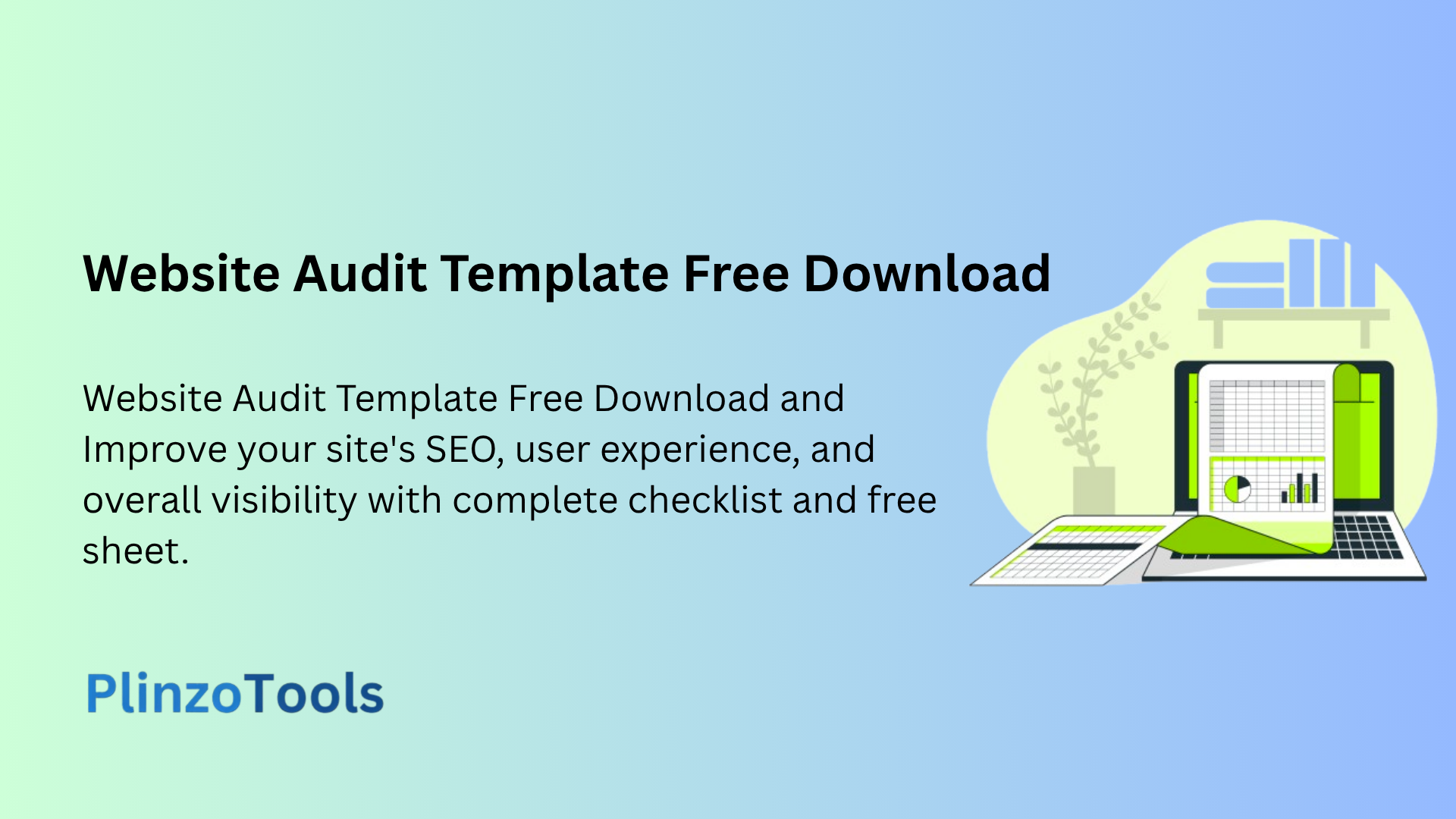
Website Audit Template Free Download – Learn SEO & Blogging

Website Audit Template Free Download: 9 Essential Areas for Boosting Your Site’s Performance
Conducting regular website audits is crucial for maintaining optimal site performance and search engine visibility. If you’re searching for a website audit template free download, this comprehensive guide provides everything you need to perform thorough site audits without spending money on expensive tools or services.
Download Website Audit Template
This Google Sheets template includes all 9 essential audit areas with detailed checklists, progress tracking, and actionable recommendations.
A systematic website audit helps identify technical issues, content gaps, and optimization opportunities that directly impact your site’s search rankings and user experience. This detailed website audit template free download covers nine essential areas that professional SEO specialists focus on during comprehensive site evaluations.
Why You Need a Website Audit Template Free Download
Website auditing can seem overwhelming without proper structure and guidance. Having access to a reliable website audit template free download ensures you don’t miss critical elements that affect your site’s performance. Regular audits help maintain site health, improve search engine rankings, and enhance user experience across all devices.
Professional website audits typically cost hundreds or thousands of dollars, but with the right template and free tools, you can achieve similar results independently. This approach makes comprehensive site analysis accessible to small businesses, bloggers, and anyone managing their own website.
Recommended Free Tools for Your Website Audit
Before diving into the audit checklist, gather these essential free tools that complement your website audit template free download:
Analytics and Performance Tools:
- Google Analytics for understanding user behavior patterns
- Google Search Console for performance data and crawling errors
- Google PageSpeed Insights for speed analysis and Core Web Vitals
Technical Analysis Tools:
- Screaming Frog SEO Spider (free version) for crawling and indexing insights
- GTmetrix for comprehensive speed analysis
- Google Mobile-Friendly Test for mobile optimization
Additional Resources:
- Ahrefs or SEMrush free versions for basic backlink analysis
- HTTPS security checkers for validation
These tools work perfectly with any website audit template free download to provide comprehensive site analysis without additional costs.
Complete Website Audit Template: 9 Key Areas
1. Basic Setup and Analytics
Every website audit begins with verifying fundamental tracking and analytics implementation. This foundational step ensures you have proper data collection for ongoing performance monitoring.
Essential Checkpoints:
- Confirm Google Analytics installation and proper configuration
- Verify Google Search Console property setup and ownership verification
- Check that tracking codes fire correctly across all pages
- Ensure goal tracking and conversion setup align with business objectives
Proper analytics setup provides the data foundation needed for effective plagiarism detection in modern education and content performance analysis.
2. Crawling and Indexing Analysis
Search engine accessibility forms the backbone of organic visibility. This section of your website audit template free download focuses on ensuring search engines can properly discover, crawl, and index your content.
Critical Elements to Review:
- Verify all important URLs return 200 status codes
- Check robots.txt file for proper directives and potential blocking issues
- Confirm XML sitemap existence and submission to search engines
- Identify orphaned pages and crawling barriers
- Review URL structure for SEO-friendly formatting
Indexing Verification Steps:
- Use site: search operators to check indexed page counts
- Compare indexed pages with actual site structure
- Identify and resolve duplicate content issues
- Check for proper canonical tag implementation
3. Meta Data and Structured Markup
Effective meta data optimization directly impacts click-through rates and search engine understanding of your content. This crucial component of website auditing requires careful attention to detail.
Title Tag Optimization:
- Ensure each page has unique, descriptive title tags
- Keep titles within 60 characters for proper display
- Include target keywords naturally within titles
- Avoid keyword stuffing and maintain readability
Meta Description Analysis:
- Check for unique meta descriptions on all pages
- Optimize length between 150-160 characters
- Include compelling calls-to-action and relevant keywords
- Ensure descriptions accurately reflect page content
Structured Data Implementation:
- Verify schema markup implementation using Google’s Rich Results Test
- Check for appropriate structured data types (Organization, Article, Product, etc.)
- Ensure markup validates without errors
- Monitor rich snippet appearance in search results
4. Content Quality Assessment
Content remains the foundation of successful SEO strategies. This section of your website audit template free download evaluates content effectiveness and optimization opportunities.
Content Analysis Framework:
- Identify duplicate content issues using plagiarism detection tools
- Assess keyword targeting and semantic relevance
- Evaluate content depth and comprehensiveness
- Check for proper heading structure (H1, H2, H3 hierarchy)
- Review content freshness and update frequencies
Quality Guidelines Compliance:
- Ensure content meets Google’s E-E-A-T standards (Experience, Expertise, Authoritativeness, Trustworthiness)
- Verify content provides genuine value to users
- Check for thin content pages requiring enhancement
- Review content organization and logical flow
Understanding essential English grammar rules improves content quality and readability, supporting better user engagement metrics.
5. Internal Linking and Navigation Structure
Effective internal linking distributes page authority and helps users navigate your site efficiently. This component of website auditing often reveals significant optimization opportunities.
Link Analysis Checklist:
- Verify all internal links function properly without 404 errors
- Check anchor text diversity and descriptiveness
- Ensure logical site architecture and navigation flow
- Review breadcrumb implementation and functionality
- Assess link equity distribution across important pages
Navigation Optimization:
- Test menu functionality across all devices
- Verify footer links and utility navigation
- Check for proper use of nofollow attributes where appropriate
- Ensure contact and legal pages are easily accessible
6. Image Optimization and Accessibility
Image optimization affects both page speed and accessibility. This section ensures visual content supports overall site performance goals.
Image SEO Checklist:
- Verify all images include descriptive alt attributes
- Check file naming conventions for SEO-friendly formats
- Ensure proper image sizing and compression
- Review image sitemap implementation
- Test image loading performance across devices
Technical Image Requirements:
- Define width and height attributes in HTML
- Implement lazy loading for improved performance
- Use appropriate image formats (WebP, JPEG, PNG)
- Ensure images scale properly on mobile devices
7. Mobile Responsiveness and User Experience
Mobile optimization has become non-negotiable for search engine rankings and user satisfaction. This critical audit component evaluates cross-device performance.
Mobile Testing Protocol:
- Use Google’s Mobile-Friendly Test tool for initial assessment
- Test site functionality across various screen sizes
- Verify touch element spacing and usability
- Check mobile navigation and menu functionality
- Assess mobile page loading speeds
Responsive Design Verification:
- Ensure content scales appropriately across devices
- Test form functionality on mobile devices
- Verify image and video responsiveness
- Check mobile typography and readability
8. Site Speed and Core Web Vitals
Page speed directly impacts user experience and search rankings. This performance-focused section of your website audit template free download identifies speed optimization opportunities.
Speed Analysis Framework:
- Measure loading times using Google PageSpeed Insights
- Assess Core Web Vitals metrics (LCP, FID, CLS)
- Identify render-blocking resources
- Check server response times and hosting performance
- Review caching implementation and effectiveness
Optimization Opportunities:
- Compress images and optimize file formats
- Minify CSS, JavaScript, and HTML files
- Implement browser caching strategies
- Consider Content Delivery Network (CDN) implementation
- Optimize database queries and server configuration
9. Security and HTTPS Implementation
Website security affects both user trust and search engine rankings. This final component ensures your site meets modern security standards.
Security Audit Checklist:
- Verify HTTPS implementation across all pages
- Check for mixed content issues (HTTP resources on HTTPS pages)
- Test SSL certificate validity and configuration
- Implement HTTP Strict Transport Security (HSTS)
- Review website backup and security monitoring systems
Additional Security Considerations:
- Update content management systems and plugins regularly
- Use strong passwords and two-factor authentication
- Monitor for malware and security vulnerabilities
- Implement proper file permissions and access controls
Advanced Website Audit Strategies
Backlink Profile Analysis
Off-page SEO significantly impacts search rankings and requires regular monitoring. Include these elements in your comprehensive audit:
Backlink Quality Assessment:
- Analyze referring domain authority and relevance
- Identify potentially harmful or toxic links
- Check for proper link attribution and context
- Monitor competitor backlink strategies
- Review disavow file necessity and implementation
Technical SEO Deep Dive
Advanced technical elements often require specialized attention during comprehensive audits:
Server and Hosting Analysis:
- Check server uptime and reliability statistics
- Review hosting performance and resource allocation
- Analyze redirect chains and implementation
- Test international targeting and hreflang implementation
- Verify proper handling of dynamic content and parameters
Creating Your Website Audit Action Plan
After completing your audit using this website audit template free download, prioritize improvements based on impact and difficulty:
High Priority Fixes:
- Critical technical errors affecting indexing
- Security vulnerabilities requiring immediate attention
- Major speed issues impacting user experience
- Mobile usability problems
Medium Priority Improvements:
- Content optimization opportunities
- Internal linking enhancements
- Image optimization projects
- Meta data improvements
Long-term Strategy Items:
- Content expansion and development
- Backlink building initiatives
- Advanced technical optimizations
- User experience enhancements
Measuring Audit Success
Track improvement progress using these key performance indicators:
Traffic and Visibility Metrics:
- Organic search traffic growth
- Keyword ranking improvements
- Click-through rate increases
- Search impression growth
Technical Performance Indicators:
- Page speed improvements
- Core Web Vitals score enhancements
- Mobile usability test results
- Crawl error reductions
User Experience Metrics:
- Bounce rate improvements
- Session duration increases
- Conversion rate optimization
- Mobile engagement metrics
Maintaining Website Health After Your Audit
Regular maintenance ensures continued site performance and prevents issues from accumulating:
Monthly Monitoring Tasks:
- Review Google Search Console for new issues
- Check site speed and Core Web Vitals performance
- Monitor security and uptime statistics
- Analyze traffic patterns and user behavior
Quarterly Comprehensive Reviews:
- Conduct abbreviated audits focusing on critical areas
- Update content and optimize underperforming pages
- Review and refresh backlink profiles
- Assess competitor performance and strategies
Common Website Audit Mistakes to Avoid
Many website owners make these critical errors during their audit process:
Incomplete Analysis:
- Focusing only on technical issues while ignoring content quality
- Neglecting mobile optimization assessment
- Overlooking security considerations
- Ignoring user experience factors
Implementation Errors:
- Making too many changes simultaneously
- Failing to document baseline metrics before improvements
- Ignoring the impact of changes on existing performance
- Not prioritizing fixes based on business impact
Conclusion
This comprehensive website audit template free download provides the framework needed for thorough site analysis and optimization. Regular auditing helps maintain competitive search engine rankings while ensuring optimal user experience across all devices and platforms.
Remember that website auditing is an ongoing process rather than a one-time activity. Search engine algorithms, user expectations, and technical standards continue evolving, making regular assessment essential for long-term success.
Start implementing these audit strategies immediately to identify improvement opportunities and maintain your website’s competitive edge. The investment in systematic site analysis pays dividends through improved search visibility, enhanced user experience, and stronger overall online performance.
Ready to start your website audit? Download this template and begin with the basic setup verification before moving through each section systematically. Your site’s improved performance and search rankings will justify the time invested in thorough analysis.
Download Website Audit Template
You can also check PlinzoTools for more useful online tools for your daily work. They are all secure and free-to-use utilities. So, do give them a try!































